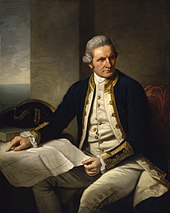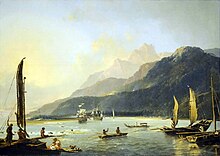User:Kusma/sandbox/GF rewrite
Johann George Adam Forster, also known as Georg Forster[nb 1] (German pronunciation: [ˈɡeːɔʁk ˈfɔʁstɐ], November 27, 1754 – January 10, 1794) was a German naturalist, ethnologist, travel writer, journalist, and revolutionary.
Early life[edit]
Georg Forster was born in Nassenhuben[5][nb 2] (now Mokry Dwór, Poland), a small village near Danzig, on November 27, 1754.[7][8][nb 3] George was the oldest of seven surviving children of Johann Reinhold Forster, a Reformed Protestant pastor and scholar, and his wife Justina Elisabeth, née Nicolai.[5][6] From an early age, Georg was interested in the study of nature, and his father first learned natural history from the books of Carl Linnaeus and then taught his son biology as well as Latin, French, and religion.[15][16] In 1765, Reinhold obtained a commission by the Russian government to inspect the recently founded colonies near Saratov on the Volga River, which were mostly settled by German colonists.[17] Ten-year old Georg accompanied his father on the 4000km journey, which reached the Kalmyk Steppe and Lake Elton, and collected hundreds of specimens of plants, helping his father with naming and identification.[18] From October 1765, he attended Saint Peter's School in St Petersburg,[19] while his father prepared a report about the state of the colony.[20] Reinhold's report was critical of the voivode of Saratov and of the conditions in the colony, and the Forsters left Russia without payment amidst quarrel with Grigory Orlov.[19][21]
try to use Hoare / Goldstein / Thomas /Saine / if possible, Uhlig for everything else :)
Participant in Cook's second voyage[edit]
The Forsters returned to London. (making money by translating) (Reinhold's scholarly work) (cultivating friends) (abortive plan with Dalrymple) (FRS) (unsuccessfully tried to become member of Banks' entourage) (Banks withdrawal) (£4000)
(voyage) (observations) (ethnology) (botany) (drawing) (art) (scientific results)
(return): (characteres) (controversy) (a voygae)
Around the world with Cook[edit]

In 1772, Forster's father became a member of the Royal Society. This and the withdrawal of Joseph Banks resulted in his invitation by the British Admiralty to join James Cook's second expedition to the Pacific (1772–75). Georg Forster joined his father in the expedition again and was appointed as a draughtsman to his father. Johann Reinhold Forster's task was to work on a scientific report of the journey's discoveries that was to be published after their return.[22]
They embarked HMS Resolution on July 13, 1772, in Plymouth. The ship's route led first to the South Atlantic, then through the Indian Ocean and the Southern Ocean to the islands of Polynesia and finally around Cape Horn back to England, returning on July 30, 1775. During the three-year journey, the explorers visited New Zealand, the Tonga islands, New Caledonia, Tahiti, the Marquesas Islands and Easter Island. They went further south than anybody before them, almost discovering Antarctica. The journey conclusively disproved the Terra Australis Incognita theory, which claimed there was a big, habitable continent in the South.[23]
Supervised by his father, Georg Forster first undertook studies of the zoology and botanics of the southern seas, mostly by drawing animals and plants. However, Georg also pursued his own interests, which led to completely independent explorations in comparative geography and ethnology.[24] He quickly learned the languages of the Polynesian islands. His reports on the people of Polynesia are well regarded today, as they describe the inhabitants of the southern islands with empathy, sympathy and largely without Western or Christian bias.[25]

Unlike Louis Antoine de Bougainville, whose reports from a journey to Tahiti a few years earlier had initiated uncritical noble savage romanticism, Forster developed a sophisticated picture of the societies of the South Pacific islands.[26] He described various social structures and religions that he encountered on the Society Islands, Easter Island and in Tonga and New Zealand, and ascribed this diversity to the difference in living conditions of these people. At the same time, he also observed that the languages of these fairly widely scattered islands were similar. About the inhabitants of the Nomuka islands (in the Ha'apai island group of present-day Tonga), he wrote that their languages, vehicles, weapons, furniture, clothes, tattoos, style of beard, in short all of their being matched perfectly with what he had already seen while studying tribes on Tongatapu. However, he wrote, "we could not observe any subordination among them, though this had strongly characterised the natives of Tonga-Tabboo, who seemed to descend even to servility in their obeisance to the king."[27]
The journey was rich in scientific results. However, the relationship between the Forsters and Cook and his officers was often problematic, due to the elder Forster's fractious temperament[28] as well as Cook's refusal to allow more time for botanical and other scientific observation. Cook refused scientists on his third journey after his experiences with the Forsters.[29]
Notes[edit]
- ^ Forster was baptised "Johann George Adam Forster", with the English spelling "George", widely used in the Danzig area at the time,[1] possibly chosen commemorating the family's ancestors from Yorkshire.[2]. The German form of his name is also common in English (for example, Thomas P. Saine's English-language biography is titled "Georg Forster"),[3] which helps to distinguish him from George Forster, a contemporaneous English traveller.[4]
- ^ Some sources indicate that the birth took place in the rectory of Hochzeit, a village very close to Nassenhuben on the other side of the Motława river.[6]
- ^ Some variants of the date of birth exist in the literature, with 26 November common in earlier literature.[9][10] The baptism registries of Nassenhuben and of St Peter and Paul, Gdańsk list November 27 as date of birth and December 5 as date of baptism.[11][12] The date of November 27 is claimed by both father and son;[13] for example, Reinhold's diary entry for November 27, 1772 starts "This day was George's birthday & we were all very happy."[14]
References[edit]
- ^ Gordon (1975), p. 9.
- ^ Forster (2000), p. 425.
- ^ Saine (1972).
- ^ Rosove (2015).
- ^ a b Forster (2000), p. xix.
- ^ a b Hoare (1976), pp. 15–16.
- ^ Enzensberger (1996), p. 10.
- ^ Uhlig (2004), p. 18.
- ^ Saine (1972), p. 18.
- ^ Hoare (1976), p. 18.
- ^ Strehlke (1861), pp. 201–203.
- ^ Enzensberger (1996), p. 15.
- ^ Uhlig (2004), p. 353.
- ^ Forster (1982), p. 184.
- ^ Hoare (1976), pp. 21–22.
- ^ Uhlig (2004), pp. 19–20.
- ^ Hoare (1976), pp. 25–26.
- ^ Hoare (1976), p. 31.
- ^ a b Uhlig (2004), p. 26.
- ^ Hoare (1976), pp. 32–33.
- ^ Hoare (1976), pp. 33–36.
- ^ Aulie, Richard P. (1999). "The Forsters at Home". The Voyages of Captain James Cook. Captain Cook Study Unit. Retrieved May 14, 2015.
- ^ Thomas & Berghof (2000), p. xxii.
- ^ Daum, Andreas (2019). "German Naturalists in the Pacific around 1800: Entanglement, Autonomy, and a Transnational Culture of Expertise". In Berghoff, Hartmut (ed.). Explorations and Entanglements: Germans in Pacific Worlds from the Early Modern Period to World War I. Berghahn Books. pp. 79–102.
- ^ Ackerknecht (1955), pp. 85–86.
- ^ Ackerknecht (1955), pp. 86–87.
- ^ Forster, Georg. A Voyage Round the World, Book II, Chapter VIII
- ^ Thomas & Berghof (2000), pp. xxii–xxvi.
- ^ Saine (1972), p. 22.
Sources[edit]
- Gordon, Joseph Stuart (1975). Reinhold and Georg Forster in England, 1766-1780 (Thesis). Ann Arbor: Duke University.
- Forster, Johann Reinhold (1982). Hoare, Michael E. (ed.). The "Resolution" journal of Johann Reinhold Forster, 1772-1775 Vol. 2. ISBN 978-0-904180-10-7. OCLC 58633015.
- Forster, Georg (2000). Thomas, Nicholas; Berghof, Oliver (eds.). A Voyage Round the World. University of Hawai'i Press. ISBN 0-8248-2091-6.
- Uhlig, Ludwig (2004). Georg Forster: Lebensabenteuer eines gelehrten Weltbürgers (1754-1794) (in German). Vandenhoeck & Ruprecht. p. 107. ISBN 9783525367315.
- Rosove, Michael H. (2015). "The folio issues of the Forsters' Characteres Generum Plantarum (1775 and 1776): a census of copies". Polar Record. 51 (6): 611–623. doi:10.1017/S0032247414000722. ISSN 0032-2474.
- Hoare, Michael Edward (1976). The Tactless Philosopher: Johann Reinhold Forster (1729-98). Hawthorne Press. ISBN 9780725601218.
- Enzensberger, Ulrich (1996). Georg Forster: ein Leben in Scherben (in German). Eichborn. ISBN 9783821841397.
- Strehlke, F. (1861). "Georg Forster's Geburtsort". Neue Preußische Provinzialblätter. 3. Folge. 8: 189–212.
- Saine, Thomas P. (1972). Georg Forster. New York, NY: Twayne Publishers. ISBN 0-8057-2316-1.
- Reintjes, Heinrich (1953). Weltreise nach Deutschland (in German). Düsseldorf: Progress-Verlag. AVOID?
- Daum, Andreas (2019). Alexander von Humboldt. Munich: C. H. Beck. pp. 19–21, 43. ISBN 978-3-406-73436-6. (humboldt influence)
- Boreham, Ian (1985). "John Reinhold Forster". Cook's Log. 8 (3). Captain Cook Society: 368. Archived from the original on September 23, 2015. Retrieved July 14, 2015. USE BETTER?
Steiner, Gerhard; Baege, Ludwig, eds. (1971). Vögel der Südsee [Birds of the South Seas] (in German). Insel-Verlag. p. 53. WHY? Daum, Andreas (2019). "German Naturalists in the Pacific around 1800: Entanglement, Autonomy, and a Transnational Culture of Expertise". In Berghoff, Hartmut (ed.). Explorations and Entanglements: Germans in Pacific Worlds from the Early Modern Period to World War I. Berghahn Books. pp. 79–102.
- Smith, Alexander (1990). Explorers of the Amazon. University of Chicago Press. p. 218. ISBN 0-226-76337-4.
- "Georg Forster Leben und Werk". Spiegel Online (in German). Archived from the original on April 29, 2017. Retrieved May 23, 2017. (Gutenberg) AVOID
- Bertschinger, George. "The Portraits of John Reinhold Forster and George Forster. A Catalog Tracing the Origin of Each Portrait". Archived from the original on May 15, 2008. Retrieved December 6, 2009. SELF-PUBLISHED, AVOID
- Aulie, Richard P. (1999). "The Forsters at Home". The Voyages of Captain James Cook. Captain Cook Study Unit. Retrieved May 14, 2015.
- Ruth P. Dawson, “Navigating Gender: Georg Forster in the Pacific and Emilie von Berlepsch in Scotland.“ In: Weimar Classicism, ed. David Gallagher. Lampeter, Wales: Edwin Mellen Press, 2011. 39-64.
- Jovanović, Lazar. "The Cosmopolitan Circumnavigator of the South Seas: A Biography of Georg Forster". Retrieved 2021-07-22.
{{cite web}}: Text "Bérose" ignored (help) - Thomas, Nicholas; Berghof, Oliver (2000n). "Notes to Volume I". A Voyage Round the World. Forster, Georg. University of Hawai'i Press. pp. 425–475. ISBN 0-8248-2091-6.
more refs[edit]
- Daum, Andreas (2019b). Alexander von Humboldt. Munich: C. H. Beck. pp. 19–21, 43. ISBN 978-3-406-73436-6.
- Daum, Andreas (2019a). "German Naturalists in the Pacific around 1800: Entanglement, Autonomy, and a Transnational Culture of Expertise". In Berghoff, Hartmut (ed.). Explorations and Entanglements: Germans in Pacific Worlds from the Early Modern Period to World War I. Berghahn Books. pp. 79–102.
- Aulie, Richard P. (1999a). "The Forsters at Home". The Voyages of Captain James Cook. Captain Cook Study Unit. Retrieved May 14, 2015.
- Smith, Alexander (1990). Explorers of the Amazon. University of Chicago Press. p. 218. ISBN 0-226-76337-4.
- Ruth P. Dawson, “Navigating Gender: Georg Forster in the Pacific and Emilie von Berlepsch in Scotland.“ In: Weimar Classicism, ed. David Gallagher. Lampeter, Wales: Edwin Mellen Press, 2011. 39-64.
- Gray, Sally Hatch (2012). "Disinterested Pleasure and Aesthetic Autonomy in Georg Forster's Voyage 'round the World". Open Inquiry Archive. 1 (5). Archived from the original on October 24, 2012. Retrieved May 23, 2012.
- Harpprecht, Klaus (2007). "Das Abenteuer der Freiheit und die Liebe zur Welt". Georg Forster: Reise um die Welt : illustriert von eigener Hand. By Forster, Georg. Frankfurt am Main: Eichborn. p. 22. ISBN 9783821862033. OCLC 173842524.
- Smith, Alexander (1990). Explorers of the Amazon. University of Chicago Press. ISBN 0-226-76337-4.
